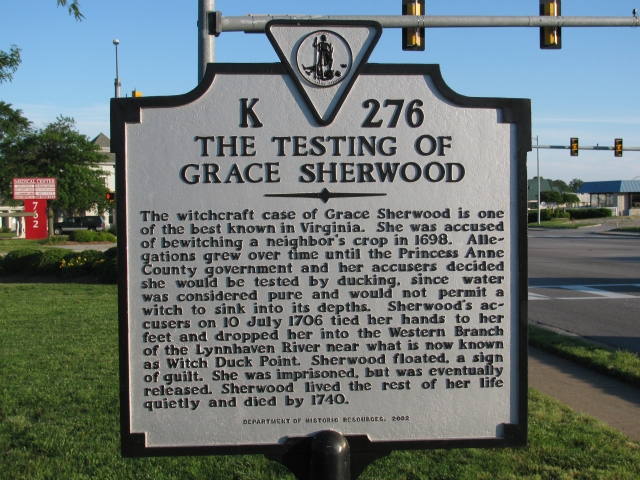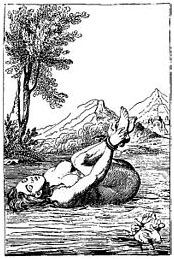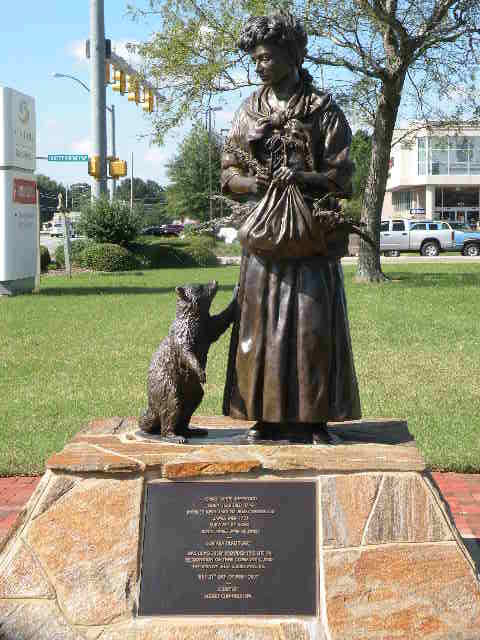|
It's a shame that we missed the
annual Witch Duck…
Last July those individuals who are into
stomping out witches and the practice of witchcraft, love to celebrate the
ducking of the only witch to be legally ducked in Virginia. Ducking witches is
a sure fire way of testing an accused witch to prove that she is really a
witch.
Grace Sherwood was the only witch that the magistrates of good
ole Princess Ann County (now Virginia Beach) ever tested, with the sure fired
forensic test of ducking. There were other witches in Princess Anne County but
none of them had the good fortune to be enshrined in the text of children's
book, or having someone write their biography.
So after all these
years that you've traveled up and down Witchduck road and suspected that it had
something to do with witches; now you know that it really is named after the
path that was traveled by a frightened women forced to undergo proving her
innocence by submitting to this forensic test.
The ducking test
consists of being bound hand to foot and thrown into water. If the suspected
witch floated; she was guilty. If she didn't float or she drowned; she was
innocent. Great justice, just what we have come to expect from Virginia
Beach
The Governor of Virginia did exonerate Grace Sherwood of all
charges; she was tried in 1706 and ducked or tested shortly after her trial.
She was finally exonerated in 2006. Grace only had to hold her breath for mere
300 years…
There's no doubt that justice is slow in Virginia;
except for traffic court. Virginia traffic courts demand their fines are paid
quickly, and all of the legal jurisdictions jointly operate a website to
expedite electronic payments. However decisions about witches, the practice of
witchcraft and the like are a little slower; by the way those old laws from the
1700's are probably still on the books… 
Grace Sherwood
Grace White Sherwood (c.
1660 - c. 1740), known as the Witch of Pungo, is the last person known to have
been convicted of witchcraft in Virginia. A farmer, healer, and midwife, her
neighbors accused her of transforming herself into a cat, damaging crops and
causing the death of livestock. She was charged with witchcraft several times;
at her eventual trial in 1706, Sherwood was accused of bewitching Elizabeth
Hill, causing Hill to miscarry. The court ordered that Sherwood's guilt or
innocence be determined by ducking her in water. If she sank, she was innocent;
if she did not, she was guilty. Sherwood floated to the surface and may have
subsequently spent up to eight years in jail before being released.
Sherwood's first case was in 1697; she was accused of casting a spell on a
bull, resulting in its death, but the matter was dismissed by the agreement of
both parties. The following year she was accused of witchcraft by two
neighbors; she supposedly bewitched the hogs and cotton crop of one of them.
Sherwood sued for slander after each accusation but her lawsuits were
unsuccessful and her husband had to pay court costs. In 1706 she was convicted
of witchcraft and was incarcerated. Freed from prison by 1714, she recovered
her property from Princess Anne County, after which she lived on her farm until
her death in 1740 at the age of about 80.
On July 10, 2006, the 300th
anniversary of Sherwood's conviction, Governor Tim Kaine restored her good
name, recognizing that her case was a miscarriage of justice. A statue
depicting her was erected near Sentara Bayside Hospital on Independence
Boulevard in Virginia Beach, close to the site of the colonial courthouse where
she was tried. She is sculpted alongside a raccoon, representing her love of
animals, and carrying a basket containing garlic and rosemary, in recognition
of her knowledge of herbal healing.
Sherwood was born in 1660 to John
and Susan White. John White was a carpenter and farmer of Scottish descent; it
is uncertain whether he was born in America. Susan was English by birth; their
daughter Grace was born in Virginia, probably in Pungo.
Grace White
married a respected small-farm landowner, James Sherwood, in April 1680, and
they were wed in the Lynnhaven Parish Church. The couple had three sons: John,
James, and Richard. John White gave the Sherwoods 50 acres (20 ha) of land when
they married, and on his death in 1681 left them the remainder of his 145 acres
(59 ha) farm. The Sherwood family was poor, and lived in an area inhabited by
small landowners or those with no land at all. In addition to farming, Grace
Sherwood grew her own herbs, which she used to heal both people and animals.
She also acted as a midwife. When James died in 1701, Grace inherited his
property. She did not remarry.
No drawings or paintings of Sherwood
exist, but contemporary accounts describe her as attractive and tall and
possessing a sense of humor. Sherwood grew medicinal herbs and wore trousers
instead of a dress while working on her farm; both traits were atypical of
ladies of that era. This combination of clothing and good looks was said to
attract men and upset their wives. Sherwood biographer and advocate Belinda
Nash suggests that Sherwood's neighbors may have been jealous of Sherwood and
that the witchcraft tales may have been conjured up in an effort to remove her
from and gain her property. Sherwood was required to go to court at least a
dozen times, in order to defend against accusations of witchcraft or to sue
accusers for slander.
Sherwood was first charged with witchcraft in a
court case held in early 1697, in which Richard Capps alleged that she had used
a spell to cause the death of his bull. The court made no decision on this
charge; the Sherwoods then filed a defamation suit against Capps that was
discontinued when the parties came to an agreement. In 1698, Sherwood was
accused by her neighbor John Gisburne of enchanting his pigs and cotton crop.
No court action followed this accusation, and another action for defamation by
the Sherwoods also failed. In the same year Elizabeth Barnes alleged that
Sherwood had assumed the form of a black cat, entered Barnes' home, jumped over
her bed, drove and whipped her, and left via the keyhole. Again the allegation
was unresolved, and again the subsequent defamation action was lost. For each
of the failed actions Sherwood and her husband had to pay court related costs.
According to Richard Beale Davis in his journal article on witchcraft
in Virginia, by this time "Princess Anne County had obviously grown tired of
Mrs. Sherwood as a general nuisance". In 1705, Sherwood was involved in a fight
with her neighbor, Elizabeth Hill. Sherwood sued Hill and her husband for
assault and battery, and on December 7, 1705, was awarded damages of twenty
shillings (1 pound sterling). On January 3, 1706, the Hills accused Grace
Sherwood of witchcraft, although she failed to answer the charge in court. On
February 7, 1706, the court ordered her to appear on a charge of having
bewitched Elizabeth Hill, causing a miscarriage.

17th-century engraving of ducking similar to that of
Sherwood |
Proceedings resumed in
March 1706; the Princess Anne County justices sought to empanel two juries,
both made up of women. The first was ordered to search Sherwood's home for
waxen or baked figures that might indicate she was a witch. The second was
ordered to look for "demon suckling teats" by examining her. In both instances,
reluctance on the part of the local residents made it difficult to form a jury
and both juries refused to carry out the search. On March 7, 1706, Sherwood was
examined by a jury of 12 "ancient and knowing women" appointed to look for
markings on her body that might be brands of the Devil. They discovered two
"marks not like theirs or like those of any other woman." The forewoman of this
jury was the same Elizabeth Barnes who had previously accused Sherwood of
witchcraft.
Neither the colonial authorities in Williamsburg nor the
local court in Princess Anne were willing to declare Sherwood a witch. Those in
Williamsburg considered the charge overly vague, and on April 16 instructed the
local court to examine the case more fully. For each court appearance, Sherwood
had to travel 16 miles (26 km) from her farm in Pungo to where the court was
sitting.
On May 2, 1706, the county justices noted that while no
particular act of maleficium had been alleged against Sherwood, there was
"great cause of suspicion". Consequently, the Sheriff of Princess Anne County
took Sherwood into custody, though Sherwood could give bond for her appearance
and good behavior. Maximilian Boush, a warden of Lynnhaven Parish Church, was
the prosecutor in Sherwood's case. On July 5, 1706, the justices ordered a
trial by ducking to take place, with Sherwood's consent, but heavy rains caused
a postponement until July 10, as they feared the wet weather might harm her
health. Sherwood was taken inside Lynnhaven Parish Church, placed on a stool
and ordered to ask for forgiveness for her witchery. She replied, "I be not a
witch, I be a healer."
Witch Duck Bay as seen from the very end of
North Witchduck Road on Witch Duck Point in Virginia Beach, looking north. This
is the place where Grace Sherwood was ducked.
At about 10 a.m. on July
10, 1706, Sherwood was taken down a dirt lane now known as Witchduck Road, to a
plantation near the mouth of the Lynnhaven River. News had spread, and the
event attracted people from all over the colony, who began to shout "Duck the
witch!" According to the principles of trial by water, if Sherwood floated she
would be deemed guilty of witchcraft; if she did not, she would be innocent. It
was not intended that Sherwood drown; the court had ordered that care be taken
to preserve her life.
Five women of Lynnhaven Parish Church examined
Sherwood's naked body on the shoreline for any devices she might have to free
herself, and then covered her with a sack. Six of the justices that had ordered
the ducking rowed in one boat 200 yards (180 m) out in the river, and in
another were the sheriff, the magistrate, and Sherwood. Just before she was
pushed off the boat Sherwood is said to have stated, under clear skies, "Before
this day be through you will all get a worse ducking than I."
Bound
across the body - her right thumb to her left big toe and her left thumb to her
right big toe - she was "cast into the river", and quickly floated to the
surface. The sheriff then tied a 13-pound (5.9 kg) Bible around her neck. This
caused her to sink, but she untied herself, and returned to the surface,
convincing many spectators she was a witch. As Sherwood was pulled out of the
water a downpour reportedly started, drenching the onlookers. Several women who
subsequently examined her for additional proof found "two things like titts on
her private parts of a black coller [color]". She was jailed pending further
proceedings.
What happened to Sherwood after her ducking is unclear as
many court records have been lost. She served an unknown time in the jail next
to Lynnhaven Parish Church, perhaps as long as seven years and nine months. She
was ordered to be detained "to be brought to a future trial", but no record of
another trial exists, so it is possible the charge was dismissed at some point.

On September 1, 1708, she was ordered to pay Christopher
Cocke 600 pounds (270 kg) of tobacco for a reason not indicated in surviving
records, but there is no mention of the payment. She appears to have been
released some time in or before 1714, since in that year she paid back taxes on
her 145-acre (59 ha) property-which Virginia Lieutenant Governor Alexander
Spotswood helped her to recover from Princess Anne County-off what is now Muddy
Creek Road. She lived the remainder of her life quietly until her death in
1740, aged about 80. She is believed to have died in August or September 1740.
Her will was proved on October 1, 1740; it noted that she was a widow. She left
five shillings each to her sons James and Richard and everything else to her
eldest son John.
According to legend, Sherwood's sons put her body
near the fireplace and a wind came down the chimney. Her body disappeared amid
the embers, with the only clue being a cloven hoofprint. Sherwood lies in an
unmarked grave under some trees in a field close to the intersection of Pungo
Ferry Road and Princess Anne Road in Virginia Beach. Stories about the Devil
taking her body, unnatural storms, and loitering black cats quickly arose after
her death, and local men killed every feline they could find; this widespread
killing of cats might have caused the infestation of rats and mice recorded in
Princess Anne County in 1743.
Many things are named "Witchduck" or
"Witch Duck" in Virginia Beach and both spellings are in use.
Grace
Sherwood's case was little known until Virginia Beach historian and author
Louisa Venable Kyle wrote a children's book about her in 1973. Called The Witch
of Pungo, it is a collection of seven local folk tales written as fiction,
although based on historical events. Sherwood's story was adapted for Cry
Witch, a courtroom drama at Colonial Williamsburg, the restored early capital
of Virginia.
A statue by California sculptor Robert Cunningham
depicting Sherwood with a raccoon and a basket of rosemary was unveiled on
April 21, 2007, on the site of the present-day Sentara Bayside Hospital, close
to the sites of both the colonial courthouse and the ducking point.
The raccoon represents Sherwood's love of animals and the rosemary her
knowledge of herbal healing. A Virginia Department of Historic Resources marker
(K-276) was erected in 2002, about 25 yards (23 m) from Sherwood's statue.
The place of her watery test and the adjacent land are named Witch
Duck Bay and Witch Duck Point. A portion of Virginia State Route 190 in
Virginia Beach, a north-south thoroughfare on its western side which traverses
Interstate 264 at exit numbers 14-16, has been named "Witchduck Road". Other
commemorations in Virginia Beach include Sherwood Lane and Witch Point Trail. A
local legend in Virginia Beach states that all of the rosemary growing there
came from a single plant Sherwood carried in an eggshell from England.
Belinda Nash, in addition to writing a biography of Sherwood, worked tirelessly
to get her pardoned. Governor Tim Kaine officially restored Sherwood's good
name on July 10, 2006, the 300th anniversary of her conviction. Annual
reenactments of the ducking have taken place since 2006. No one is actually
ducked in these events, which embark from a spot across from Ferry Plantation
House along Cheswick Lane, which is very close to Witch Duck Bay. According to
local residents, a strange moving light, said to be Sherwood's restless spirit,
still appears each July over the spot in Witch Duck Bay where Sherwood was
thrown into the water. |


